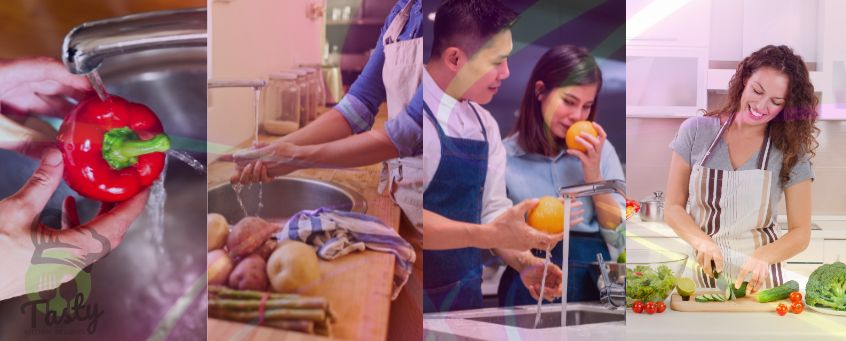Mastering Food Hygiene While Cooking
Cooking is an art, but it’s also a responsibility. Every time we step into the kitchen, we’re not just creating delicious meals; we’re also guardians of our family’s health. Food hygiene isn’t just a fancy term chefs throw around – it’s a crucial practice that keeps nasty bugs at bay and ensures our culinary creations are as safe as they are tasty.
In this article, we’ll explore the ins and outs of food hygiene while cooking. From proper hand washing techniques to the right way to handle raw meats, we’ve got you covered. So, let’s roll up our sleeves and dive into the world of kitchen cleanliness!
The Foundation: Proper Hand Washing
Why It Matters
You might think you know how to wash your hands, but when it comes to food preparation, there’s more to it than you might realize. Proper hand washing is your first line of defense against foodborne illnesses.
The Right Way to Wash
Here’s a step-by-step guide to washing your hands effectively:
- Wet your hands with clean, running water (warm or cold).
- Apply soap and lather well.
- Scrub all surfaces of your hands for at least 20 seconds. Don’t forget between your fingers and under your nails!
- Rinse thoroughly under running water.
- Dry your hands using a clean towel or air dry them.
Remember: Wash your hands before you start cooking, after handling raw meats, and any time you switch between different food items.
Keeping Your Workspace Clean
The Importance of a Clean Kitchen
A clean kitchen isn’t just about appearances – it’s about creating a safe environment for food preparation. Bacteria can lurk on countertops, cutting boards, and utensils, so keeping everything spick and span is crucial.
Essential Cleaning Tips
- Use hot, soapy water to clean surfaces before and after food preparation.
- Have separate cutting boards for raw meats and vegetables to prevent cross-contamination.
- Regularly clean and sanitize your sink, especially after washing raw meats.
- Don’t forget to clean less obvious places like refrigerator handles and microwave buttons.
Safe Food Storage
Refrigerator Rules
Your refrigerator is like a safe haven for your food, but only if you use it correctly. Here are some guidelines to follow:
- Keep your fridge temperature at or below 40°F (4°C).
- Store raw meats on the bottom shelf to prevent juices from dripping onto other foods.
- Use airtight containers to store leftovers and consume them within 3-4 days.
Pantry Pointers
Dry goods need proper storage too. Here’s what you need to know:
- Store dry goods in airtight containers to keep out pests and moisture.
- Check expiration dates regularly and follow the “first in, first out” rule.
- Keep your pantry cool and dry to extend the shelf life of your items.
Cooking Temperatures Matter
The Danger Zone
Bacteria thrive between 40°F and 140°F (4°C to 60°C), known as the “Danger Zone.” Keeping food out of this temperature range is crucial for safety.
Cooking to Safe Temperatures
Different foods require different internal temperatures to be safe for consumption. Here’s a quick guide:
- Ground meats: 160°F (71°C)
- Poultry: 165°F (74°C)
- Pork: 145°F (63°C)
- Fish: 145°F (63°C)
Invest in a good food thermometer to ensure your dishes reach these temperatures.
Handling Leftovers Safely
Cooling and Storing
Proper handling of leftovers is just as important as cooking the meal itself. Follow these steps:
- Cool food quickly by dividing large portions into smaller containers.
- Refrigerate leftovers within 2 hours of cooking (1 hour if the temperature is above 90°F/32°C).
- Reheat leftovers to 165°F (74°C) before serving.
When in Doubt, Throw it Out
If you’re unsure about the safety of leftovers, it’s always better to err on the side of caution. If food looks or smells off, or if you can’t remember when you cooked it, it’s best to discard it.
Conclusion
Food hygiene might not be the most glamorous part of cooking, but it’s undoubtedly one of the most important. By following these guidelines – from proper hand washing to safe leftover handling – you’re not just cooking meals; you’re safeguarding your family’s health.
Remember, good food hygiene practices are a habit. They might take a little extra time and effort at first, but soon they’ll become second nature. And the peace of mind that comes with knowing you’re serving safe, healthy meals? That’s priceless.
So the next time you step into your kitchen, think of yourself as not just a cook, but a guardian of food safety. Your family’s health is in your capable, clean hands!


